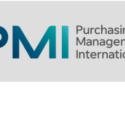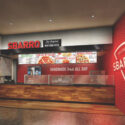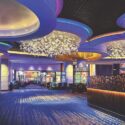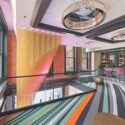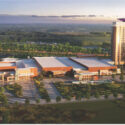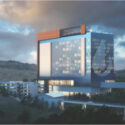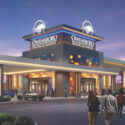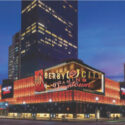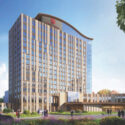We asked them key questions about design trends for today’s casinos, about the uses and drawbacks of new technologies, about the growth of green initiatives, and about the problems of building and operating in a challenging economy. Then we sat back and let them talk.
Nineteen design and construction experts shared their perspectives. Most agree that “clean, edgy, contemporary” design is dominant today; they are adamant about the importance of good design principles, high quality materials and proper programming. To succeed, they agree, one must understand the customer profile, adhere to the client’s budget and facilitate the client’s vision.
In the words of a roundtable participant, “We must dazzle the eye and soothe the senses.”
Everyone acknowledges that “green is grand” and here to stay. Environmental initiatives are responsible, marketable, appropriate and sustainable. Palazzo, a Sands property on the Las Vegas Strip, is an example of a casino that’s won applause for its use of green technology. It’s the largest green building in the world to date, and a recent recipient of the U.S Green Building Council’s Leadership in Energy and Environmental Design Silver Certification. LEED certification is viewed as a benchmark of achievement in healthful environment and responsible use of resources.
Our experts also agree that technology has revolutionized the way we communicate. Transmission of information over web-based and other technologies greatly improves accuracy and speed of delivery; it also makes it easier to dialogue with multiple disciplines domestically and around the world. Technology has increased efficiencies and cut costs. It is also ever-evolving, so stay tuned for new and exciting programs.
The capital market, the cost of raw materials and labor challenges are of great concern to the majority of our experts, as is the disappearance of skilled vendors and craftsmen.
Here’s what they told us.
Please identify the most significant design trend today and why it’s at the top of your list.
BRINKERHOFF: As in the past, a “trend” is determined by the owner’s vision. Many owners are now going “South Beach,” others are more minimalist in their preference and some remain convinced that traditional “theming” is still valid.
DOUGALL: Design trends have changed worldwide, and Las Vegas is now playing catch-up. Hip boutique hotels and restaurants with celebrity chefs have been the impetus for this change. Youth is being promoted more than ever before. But the baby boomers don’t want to be left out; they’ll hang on to every last bit of their youth, including staying in hotels designed for guests ranging from 24 to 63!
DOUGLAS: The most significant trend is the continuing segmentation of the marketplace, and tailoring experiences to individuals. Why? Because guest expectations are higher. They expect more that’s directly relevant to their particular interests. It will be our charge to translate this objective into viable casino destinations.
EWING: The proportion, scale and environmental comfort of a gaming space are so important to the psyche of today’s customer. Lighting is also critical to the success of a well-designed casino.
FRIEDMUTTER: The newer, younger gaming customer is well traveled with more sophisticated and modern expectations. This customer routinely combines work and play, and we’re able to offer this convergence by bringing technology, leisure, business and entertainment into one mixed-use facility.
GARDNER: Environmental consciousness is the most important issue the design industry will address in years to come. We’ve barely scratched the surface in the gaming industry, but the shift toward sustainable design is gaining momentum-especially on the West Coast (United States).
HARMAN: Larger and larger projects are being built on smaller, more limited sites. There’s an ongoing trend to upgrade the exterior aesthetics of the highly visible parking garages, because they are a prominent part of a project’s overall appearance.
HOSKENS: Casino resorts are becoming complete retail entertainment mega-centers. They are creating their own unique urban fabric and they must be sustainable both in design and throughout their operation.
LANGEMADE: Many designers are now incorporating the desk, credenza, mini-bar, coffee service, television and storage drawers into one piece of furniture. Bathroom vanities are purchased inclusive of plumbing fixtures, stone tops, mirrors, bowls, etc.-as one piece. This trend requires detailed planning on how to build the furniture to economize shipping and installation. The biggest challenge is making sure we can fit this set-in-place furniture into the elevator, through the guest-
room doors and into the contractor’s finished opening!
O’CONNOR: A definitive emphasis is being placed on “timeless” design-forward statements for both buildings and spaces. As the hospitality industry embraces the “entertainment” aspects of shopping, dining and gaming, we’re seeing more adventurous solutions aimed at a younger, more sophisticated patron. Also essential: quality materials that integrate luxe with technology.
PRIFTI: Theming is still “in”-it just doesn’t mean what it used to mean. Successful design today is an aspirational design, defined by the tastes of the wealthy and applied to a mass-market audience. We characterize this as a simpler yet sophisticated approach, exemplified by high-end modernism.
SPARER: The most significant design direction today is the concept of sustainability. I would not classify this “green awareness” as a trend, as that implies a short-lived awareness. Rather, I see the whole concept as a paradigm shift in how architects will design buildings for generations to come. Also I believe that a new, sophisticated architecture is on the horizon, such as CityCenter and Echelon. It’s a reflection of the more universal, educated world traveler who has developed a deep appreciation for refined design.
UDELL: Utilizing interactive lighting, video, LED and computer-based programs to accommodate for the changeability the casino industry demands. This allows the casino operator to create different types of environments, instantly, whether it’s for the change of seasons, a special event or to create a very special environmental niche.
VANCE: Beyond the non-thematic approach is the dynamic targeting of the customer. Properties need to not only provide comprehensive and diverse services, but make environmental changes quickly and freely as demands change, keeping the property perpetually fresh and exciting. For example, restaurants and clubs that are not doing well will be walled up, replaced, and renamed. With respect to gaming, we’ll see more virtual table games, and the ability of slot floors to change their mix overnight to meet the current demographics of the day. The slot machine will be a box with software serving as the agent of instant change.
WALLS: In the past 10 to 15 years in Las Vegas we have seen an increase in the high-profile retail venue and celebrity chef restaurant. Customers must now be entertained by the architecture of these interior spaces as part of the product, providing them with an immersive experience.
Are you building green or specifying more green products for the casinos you design or construct?
BRINKERHOFF: Yes. We’re seriously considering all options that save water and minimize waste while still maintaining a viable resort environment. Our projects have standard water-saving features such as drip irrigation systems as well as drought-tolerant and desert-sensitive plant materials. We encourage natural light for interior-scapes whenever possible.
DOUGALL: Every current project we have is using LEED criteria, which affect every single thing we specify from carpets, paints, wall covering and furnishings, just to name a few.
EWING: Casinos are complicated, integrated spaces; you have to approach green design in pieces. We pay particular attention to the introduction of natural light into our casino design while at the same time employing passive solar techniques in order to control heat gain.
FRIEDMUTTER: Our clients are requesting more green design strategies and products. For example, Sheik Mohamed of Dubai has introduced an edict that all projects in the jurisdiction are to be designed to a minimum of Silver LEED certification. Our projects in Dubai reflect this. Clients are looking for ways to be as green as possible without sacrificing customer expectations.
FO: In the design of our projects worldwide, we consider solar heating, lighting occupancy sensors, waste recycling, moisture and AC controls, recycled building materials, low-emitting interior materials and finishes, water conservation strategies such as low-flow water in showers, and rapidly renewable materials.
GARDNER: We think energy and water-efficient strategies, indoor air quality, sustainable management practices and sustainable development initiatives have the most direct long-term environmental impact in the gaming industry.
MARMAN: Structural concrete and structural steel are already green! Hard to believe? Structural steel used in the United States is manufactured with more than 85 percent recycled content (on average). Concrete is primarily limestone, which is the most abundant mineral on earth. It can also be made with fly ash, slag cement and silica fume, all waste byproducts from power plants, steel mills and other manufacturing facilities.
HOSKENS: All of our projects follow a “project green card” approach whereby the project team, along with our clients, continuously evaluate design decisions based on economic, environmental, social and cultural aspects.
LANGEMADE: We are fully engaged in incorporating green products and practices into all of our projects. We buy from more local factories, use emission free products, ask manufacturers to reduce packaging and use recycled or recyclable materials. We are also asking certain vendors to pick up and recycle their products at the end of their useful life on a casino property.
RIZZO: We are involved with MGM’s Project CityCenter, which is reported to be the largest LEED-certified building program ever attempted.
THALDEN: Sustainable architecture is here to stay. Flagrant wastes of water, energy and other precious resources will no longer be acceptable. Our firm is very much involved in the green building movement as sustainability fast becomes the industry standard.
VANCE: Remarkably nearly all of our clients are asking for green approaches to their projects. They see themselves as responsible stewards of our environment and consequently are asking for recycled products as well as energy efficient electrical and mechanical energy systems throughout their projects.
What design trends are now passé?
FO: Trying to be everything to everybody.
FRIEDMUTTER: “Theming” has been used to describe transporting customers to a different time and place through the built resort environment. We still transport people, but through lifestyles. These lifestyle trends are usually aspirational, making people feel richer, younger, sexier, stylish, famous, beautiful and fun.
HEDGE: Drawings prepared by hand are now passé. We have software that allows a freehand drawing to be generated electronically. The folks I tutored under showed me the good old ways, and many of those techniques are still useful now; we just tend to let the machine do more of the thinking.
HERETAKIS: Modern luxury. As strong as Red Rock is in its design and detail, and as an example of money well-spent for the “wow” factor, it’s been diluted as a style by poorly done knock-offs!
O’CONNOR: Good design should never be passé. But popular taste is fickle. The construction field experienced an entire missing generation of stonemasons because granite and marble fell out of favor in the ’70s and ’80s. Now that we’ve rediscovered the desirability of stonework, a new generation of craftsmen has to be trained! Now they can’t tool the work fast enough.
PRIFTI: There are lots of different trends, just as there are lots of different tastes. What’s passé? Perhaps it’s the use of overt historic or geographic pastiche as theme. We do benchmark older properties, evaluating each for core competency. This informs our current work, which typically appears in the marketplace three to four years after a project starts.
SPARER: The concept of themed architecture has finally run its course here in Las Vegas. This is not to say that some of the most successful examples of this genre are not well done, such as Paris Las Vegas, but the approach seems to be at the end of its lifecycle.
UDELL: The buffet seems to be giving way to upscale optional food. We are not designing for the 50-to-70-year-old group, but to a much younger group of patrons. Also, the heavily fantasized space of the stage theater is disappearing as new theaters based on modern technology are emerging.
VANCE: “In-your-face” gaming. In the past, when you walked into a property, the first thing you saw was a wall of slots. Now, it’s anything but. Look at the Venetian, the Wynn, the Bellagio or the Palazzo. It actually takes you a bit of time to find the gaming floor, which is refreshing for the customer. Another passé trend; literal thematic design approaches. The design trends of this industry are now echoing the evolving mainstream approach, which is “Just do good architecture.”
Is technology playing an important role in design/construction? How much is web-based?
BRINKERHOFF: The use of video conferencing, CAD (in all its ever-evolving forms) and other tools have made working with multiple disciplines, domestic and internationally far more feasible.
DONNELLY: Definitely! As the landscape environments we install get more and more complicated (such as rooftops in tightly restricted areas of access), executing ambitious efforts requires sophisticated software tools for quantity surveys, and 3D modeling for pipe runs and below-surface support structures. Technology is essential in developing integrated and precise construction schedules.
DOUGLAS: Almost 100 percent is web-based using collaboration tools and programs such as Buzzsaw, Google Earth, Aconex and Generations. Being highly adept technologically also allows us the freedom to design projects worldwide while still providing hands-on service.
FRIEDMUTTER: Everything from our presentations to documentation to the way we conduct meetings has changed extensively over the last five years. We use Revit, a building information model-based design and documentation tool to create all our projects. We utilize many graphic, 3-D animation and video technologies to assist our clients in the visualization, development and evolution of their projects. Also, our offices are connected to one main server, allowing all offices to collaborate on a project in real time. We can have face-to-face meetings with our clients around the world.
HEDGE: Technology plays a huge role in our profession. Computers are faster and the software allows us to make changes and revisions like we never imagined. The downside is that we pay hefty licensing fees for the software.
O’CONNOR: Technology is a major driver both in design and construction. For instance, construction techniques employing computer-laser technology create intricate patterns in stone and terrazzo fabrication and carpet design/manufacture. Also, construction sequence and shop drawing review applications can be time-compressed for greater cost savings.
RIZZO: The use of three-dimensional drawings to coordinate and integrate structural, electrical, mechanical, plumbing and sprinkler design is being successfully used to minimize conflict in layout.
RYDER: With the advent of new estimating software programs and tools, technology has helped us to become more efficient, has increased bid accuracy, and allows us to create various reports that detail unit costs and highlights areas of scope inclusion. These clearly illustrate to the client what they’re buying and where they are spending their dollars.
THALDEN: We’ve been stretching the envelope on a new technology breakthrough that’s changing the way architecture is done. It’s called Building Information Modeling. This is the most significant change in architecture since the Renaissance in the 1500s. We are no longer drawing on two-dimensional sheets. Instead, we’re virtually creating the buildings in three dimensions in the computer. Some of the advantages: better quality documents, ease on examining design options, greater ability to visualize 3-D fly-arounds or virtual walk-throughs, a constant flow of digital information during construction, just to name a few.
WALLS: Technology continues to take an increasingly crucial role in the architectural process. Document transmission is being condensed to the electronic transfer of drawings, correspondences, RFIs, submittals, etc. This new process has increased the productivity of our offices but raised a concern about proper recordkeeping, as in many cases physical paper copies do not exist unless properly processed and logged.
The increase in the cost of construction is affecting all gaming jurisdictions. How much does it affect your business?
DONNELLY: To help clients manage costs, we have dedicated our best estimating and scheduling people to form a professional pre-construction services team. This allows us to provide real-time budgeting, construction ability and scheduling analysis early in the design and development process, so fewer cost surprises pop up during construction. A successful collaboration with the landscape architect through pre-construction and beyond ensures that the owner is getting more landscape value for every dollar invested.
FO: Due to rising costs you have to plan more efficiently and you have to be more careful from the outset. The design process is an evolution so you have to monitor costs at all stages. Cost consultants now are brought on to the team from day one.
FRIEDMUTTER: We recognize that market conditions are cyclical. The current conditions are helping to stabilize many of the construction costs, giving owners the opportunity to look ahead in order to design and implement renovation or expansion projects in anticipation of the next cycle.
HEDGE: The increase in construction costs has definitely impacted the gaming industry. But I think the shake-up in the residential construction and commercial/residential (mixed use) lending market has had a greater impact on our business. Many high-rise condos have been stopped before we even complete their design. Alternatively, we had several projects for which we completed the majority of design that were never constructed.
HERETAKIS: Many of our projects have been put on hold because of escalating construction costs on other projects our owners are involved in.
LANGEMADE: For the first time in many years, we’re seeing double-digit increases in the cost of furnishings. We’re also faced with higher labor costs, higher fuel costs and competition from China and India on raw goods. There is a shortage of qualified vendors and other service providers to adequately service all the casino projects underway globally.
RIZZO: The costs of all elements of a building (i.e. labor, material and equipment) are obviously very sensitive as cost increases. The cost of raw materials, the fabrication and the transportation are all affected by the ever-increasing cost of energy.
RYDER: The spiraling price of oil alone has affected everything from fuel to PVC pipe to irrigation components to insulated wire. With regards to hardscape, the prices of steel, copper, aggregates, concrete, stone and glass are the key elements driving up the cost of finished flatwork, pools, water features, masonry, fencing, railings, etc. This obviously has a
huge impact on our business.
VANCE: Volatile and ever increasing construction costs are affecting every facet of the build environment. We as architects are no longer willing or able to provide opinions of probable costs for our clients. The result is a process change that we have used for years in the commercial sector, “Design-Assist.” Selecting a contractor at the onset of a project (based on GCs and fees) provides the design team with real-time cost data that ensures that the project is kept within the owner’s budget.
PARTICIPANTS:

Don Brinkerhoff, Chairman and CEO, Lifescapes International, Inc.
Don Brinkerhoff guides Lifescapes International’s award-winning landscape architectural design team on virtually all projects worldwide. “I guess you could say I’m the visual storyteller for the company,” Brinkerhoff says. He received his profession’s highest honor when he became a fellow in 1998 of the American Society of Landscape Architects. His industry contributions include landscape terminology (“softscape,” “hardscape”) and cobblestone-patterned concrete paving (now an industry standard).

Tom Donnelly, President, ValleyCrest Landscape Development
Thomas Donnelly joined ValleyCrest in 1980 and became vice president in 1984. He developed relationships with key national clients, opened several new offices and managed operations through the 1996 Olympics. He continues to expand operations throughout the Southeast, principally North and South Carolina, Tennessee and Alabama, and manages national expansion of the company’s site development capabilities. He is a member of the American Society Landscape Architects and the Urban Land Institute.

Terry Dougall President, Dougall Design Associates, Inc.
Since 1988, Terry Dougall has created some of the most talked-about casinos and retail projects in the gaming industry: Mandalay Bay, Borgata, the Monte Carlo, the Forum Shops at Caesars, and the lion concept for the corner marquee of MGM Grand. Current projects include Echelon Las Vegas, to open in late 2010, the Cosmopolitan Resort and Casino, opening in late 2009 and the just-completed Planet Hollywood Resort and Casino in Las Vegas.

Jonathan F. Douglas, Managing Principal, VOA
Jonathan Douglas has been VOA principal-in-charge on large-scale leisure entertainment/hospitality projects throughout the U.S., the Caribbean and the United Arab Emirates. His design approach reflects the philosophy that visitors and guests want to be informed and entertained. Douglas believes that themes and messages that “tell a story” lead to a memorable experience. He has been quoted in numerous business and trade publications on architectural design in the resort and hospitality sector, and the growing green movement.

Brett Ewing President, Marnell Architecture
Prior to joining Marnell, Brett Ewing worked for firms in Nevada and Colorado. He is a registered architect in those states as well as California and Idaho. Certified by the National Council of Architectural Registra- tion Boards, he is also a member of the American Institute of Architects, the International Council of Building Officials and the National Association of Industrial and Office Parks. He graduated summa cum laude from the University of Idaho, Moscow.

Tom Fo, Associate Vice President, WATG
Since joining WATG in 1985, Tom Fo has worked on most of the firm’s high profile gaming projects including the Venetian and Grand Canal Shoppes in Las Vegas and the Tropicana in Atlantic City. Fo has led design efforts on projects around the globe and served as senior project designer for Disney’s Grand Floridian Beach Resort at Walt Disney World and Disney hotels in Paris, Tokyo and Hong Kong. He has also directed design efforts on a multi-resort destination in the Maldives, and a luxury resort in Morocco.

Rick Gardner, Partner and Principal, Hnedak Bobo Group
As the leader of HBG’s largest design studio serving the entertainment and hospitality markets, Rick Gardner has directed teams from concept design through client occupancy on an array of technically challenging and intricate large-scale projects from coast to coast. He directed the $170 Million Greektown Casino Resort project in Detroit, a complex urban expansion of an existing casino. He is currently leading design teams on two significant confidential destination resorts on the West Coast.

Mark Hedge, Principal, Civil Engineer and Co-Owner, Lochsa Engineering
Before founding his own firm, civil engineer Mark Hedge was project manager on projects like the MGM Theme Park, Golden Nugget Laughlin, Boulder Station, Bellagio, and the Orleans. He was civil principal-in-charge at Fiesta Rancho, Wynn Las Vegas, Mandalay Bay, CityCenter, Fontainebleau, the Palms, Panorama Towers, One Las Vegas, Pala Casino and the MGM Grand. His company, based in Las Vegas and Boise, provides civil, structural and traffic engineering and surveying.

Paul Heretakis, Vice President, WESTAR Architects
Paul Heretakis has more than 15 years of experience with the top gaming and hospitality companies in the world (Venetian, Bellagio, MGM Mirage, Caesars, Harrah’s Entertainment, Trump) and celebrity chefs (Mario Batali, Paula Deen, and Georges Perrier). He has established design studios offer branding, restaurant development, client-driven vision process, innovation laboratory and alternate revenue studios. WESTAR Architects continues to be ranked as one of the top hospitality design companies in the country.

Tom Hoskens, Principal, Cuningham Group
Tom Hoskens has over 30 years of experience in architecture with an emphasis on casinos, hotels and entertainment. He was principal-in-charge for $3 billion worth of destination resort design in the last four years alone. Hoskens’ commitment to client satisfaction includes highly responsive architectural and engineering teams. “Each team responds directly to the client to help drive clarity of communication and accuracy of information,” he says, ensuring large-scale, complex projects are completed on time and within budget.

William Langmade, President, Purchasing Management International
William Langmade has more than 20 years of hospitality construction, management and purchasing experience. His company, providing furniture, fixtures and equipment for the hospitality and gaming industries, has purchased and installed over $1 billion dollars in hotel, resort and casino furnishings, operating equipment and systems worldwide. The company is headquartered in Dallas with offices in Las Vegas, Guadalajara, Cancun, and New Delhi, India. PMI is also gaming’s leading purchasing company agent.

Tom O’Connor, Founding Principal, SOSH Architects
Tom O’Connor has helped grow SOSH into a powerhouse, designing projects for the country’s best-known hospitality, gaming and entertainment clients. With offices in Atlantic City and New York, O’Connor is working on projects coast to coast as well as in the U.K., Europe and the Middle East. O’Connor accepted the Sarno Award for casino redesign for the Spotlight 29 Casino in Palm Springs, and the McGraw Hill 2007 Best Adaptive Reuse Award for Harrah’s Chester Downs.

Michael Prifti Principal, BLT Architects
Michael Prifti is a fellow of the American Institute of Architects and an award-winning professional with experience in new construction, adaptive re-use projects and project management. Prifti is currently leading the 5.5 million-square-foot Revel casino mega-resort in Atlantic City and supports BLT’s project teams for both the Water Club, a 40-story glass hotel tower addition to the Borgata in Atlantic City, and Echelon, the $4 billion resort planned for the Las Vegas Strip.

Dick Rizzo, Vice Chairman, Perini Building Company
Dick Rizzo is responsible for market planning and research at Perini, and oversees marketing strategies with particular emphasis on developing national clients. With more than 40 years of experience, Rizzo helped steer Perini into the hospitality and gaming industry. It has since become the nation’s largest builder of hospitality and gaming projects, with a project list that includes Paris Las Vegas, Caesars Palace, and Trump International. Perini is currently building MGM Mirage’s CityCenter.

Bart Ryder, Partner, Tracy & Ryder Landscape, Inc.
A seasoned landscaping professional with 30 years of experience, Bart Ryder is a partner at Park West Companies Inc. of Rancho Santa Margarita, California and its Las Vegas arm, Tracy & Ryder Landscaping. The companies provide work site development from concrete and electrical foundations to landscaping and irrigation. Notable Las Vegas projects include the Red Rock Casino, the Palazzo and the upcoming Fontainebleau Casino, as well as the Lake Las Vegas Resorts. Born in Orange, California, Ryder studied at the Marshall School of Business at USC and graduated in 1981.

Jon Sparer Principal, YWS Architects, Ltd.
Jon Sparer perceives the world visually, and always with pencil in hand. In 2001, he joined Tom Wucherer to form YWS; the firm has since grown in size and caliber with more than 30 gifted employees. YWS projects span the industry and the globe: from Las Vegas, where the firm devised the “light as architecture” concept for the Rio porte cochere, to China, where it created the concept design for MGM Grand Macau.

Barry Thalden, Partner, Thalden Boyd Emery Architects International, Inc.
With more than 35 years in hotel and casino design, Barry Thalden specializes in the design and architecture of hotels, casinos and related hospitality projects; its portfolio includes more than 400 hotels and 100 casinos. Currently working with over 40 Native American tribes in the development of gaming facilities, Thalden·Boyd is an associate member of the National Indian Gaming Association and the California Nations Indian Gaming Association.

Rebecca Udell President, Floss Barber, Inc.
Rebecca Udell works to sustain Floss Barber Inc.’s reputation as a national boutique interior design firm while expanding into the international market. Her analytical and strategic skills enhance her design capabilities. Udell believes that understanding the client’s needs and how they want to represent themselves both internally and externally to their clientele can be captured in the interior environment, which in turn strengthens the company’s brand identity.

Ed Vance, President and CEO, Ed Vance & Associates
For 25 years, design excellence has characterized Ed Vance’s career. His work has led to numerous awards and significant commissions with major hospitality, commercial, and health care clients. Among other awards, Vance has received The AIA Nevada Silver Medal, the highest honor bestowed on an architect in the state. He is a past professor at UNLV’s College of Architecture, where he continues to guest lecture, and is a registered architect in 14 states.

Scott Walls, President, COO and Co-founder, Bergman Walls Architects
Scott Walls has been partner-in-charge for the Augustus Tower, Palace Tower and numerous suite, lounge and restaurant remodels at Caesars Palace Las Vegas. Upcoming projects include the Octavius Tower, Fontainebleau, the Sahara and the Majestic Star Casino in Pittsburgh. A graduate of the School of Architecture at Syracuse University, Walls spent 10 years on design teams for projects such as the Mirage, Treasure Island and all the Golden Nugget properties.



